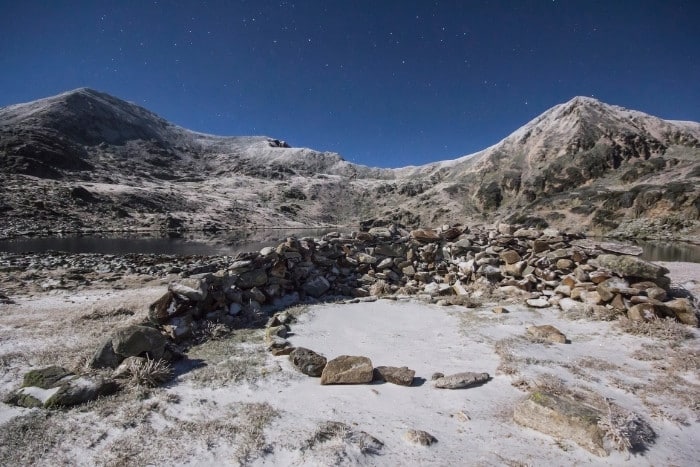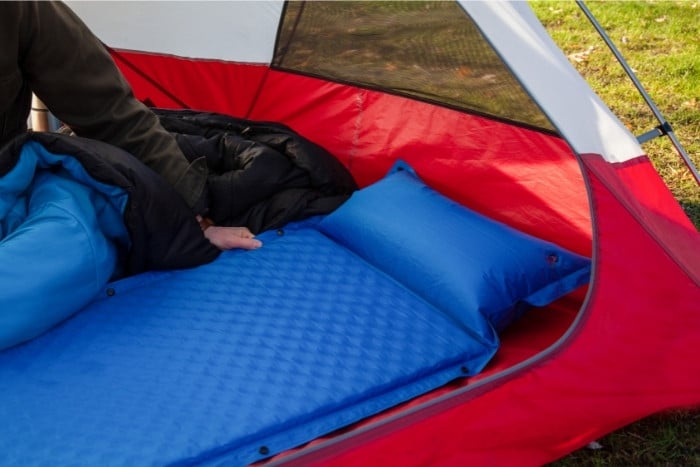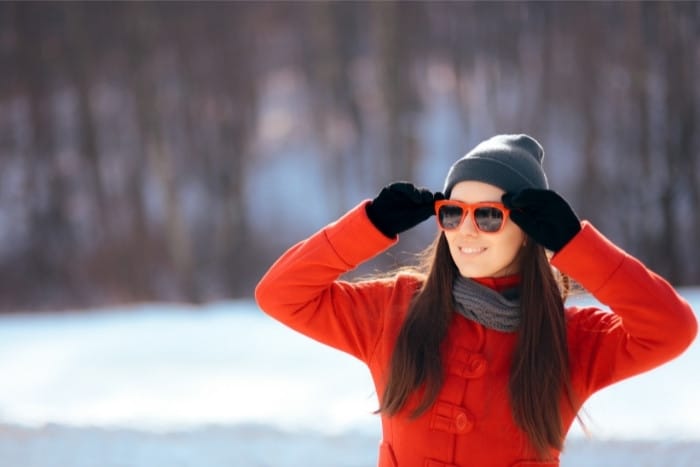You love camping so much that you wish you could experience it all year-round. Maybe you heard of winter camping and are wondering how to brave the elements successfully. Winter camping is a unique and fun way to enjoy the winter weather – if you’re adequately prepared.
Winter camping is camping in winter weather with snow and ice. You’ll need to prepare with the right wind-resistant clothing, sleeping bags, insulated sleeping pads, and sturdy tent. Pack a few essentials like Vaseline, sunscreen, toilet paper, and eye protection. Hydrate and eat often to warm up.
If you’re thinking about planning a camping trip in the cold weather, here’s what you need to know about this fun type of winter excursion and how you should prepare.
How Do You Winter Camp?
Winter camping is exactly what it sounds like: going out into the elements so that you can camp in the dead of winter.
This type of camping should only be done by experienced campers who know how to protect themselves and have the gear needed to make a trip successful in the bitter cold.
In many parts of the country, you’ll face freezing temperatures and snow and ice, so you need to be prepared.
If you intend to go camping during the winter weather, you should know a few things.
Here’s what you need to do to make the most of your winter camping trip and how to prepare for it.
1. Choosing a Camping Spot
One of the first and most important aspects of winter camping is choosing the right campsite.
Chances are that you won’t be able to avoid the snow altogether, but you can minimize how cold you’ll be once the sun goes down.
Look for a place that’s relatively sheltered from the wind. If there’s snowfall, make sure you aren’t in the range of an avalanche.
You might want to camp near trees or on the downside of a nearby hill.
Once you settle on the ideal spot for your campsite, you can start to make your camp.
Pack down the snow where your tent will be using snowshoes, skis, or just your snow boots. Then, you can pitch your tent like you usually would.
If you neglect to pack the snow down first, you might step into a soft spot and end up tearing the floor of your tent.
If you cannot find a place sheltered from the wind, you can use extra snow to build a wall around your tent.
This will keep the wind from whipping through the thin fabric of the tent and help insulate you in the middle of the night.

2. Water Keeps You Warm
One of the things that many campers often forget to do while winter camping is to stay hydrated.
During the summer months, when you’re hot and sweaty, it’s easy to think about quenching your thirst all day.
Chances are you even carry a water bottle with you everywhere you go. In the winter, most people neglect their hydration.
Why does drinking water matter?
The human body utilizes water to keep a consistent inner temperature, whether you’re too hot or too cold.
If your body doesn’t contain enough water, you won’t be able to reach that point of homeostasis.
As a result, dehydration can directly lead to feeling cooler than you otherwise might.
3. Eat More
Much like drinking water helps your body to remain comfortable and balanced, eating more can produce a similar effect.
You’ll want to eat as many hot meals as possible because it can make you warmer from the inside out. However, eating more than warms you for a few brief minutes.
Foods with higher calories will take a bit longer to digest.
You can also opt for foods that are more challenging for the body to digest instead of consuming sugary foods and drinks.
Anything with high fat, protein, and carbohydrate content is a good choice to help you keep warm.
One of the easiest foods to prepare that meets these criteria is a bowl of oatmeal.
As long as your body is working to digest your food, it can raise the body’s temperature in a process known as thermogenesis.
4. Invest in the Right Gear
If this is your first time winter camping, you’ll want to invest in gear that will help you stay warm all day and all night.
The same thin sleeping bag and tent you use during the peak of summer weather simply won’t be sufficient for winter weather.
Plan to set aside some money to purchase new equipment or borrow it from a friend.
Winter tents will be much sturdier to keep the icy chill out of your sleeping area.
The thicker material of the tent will also cut down on the wind that passes through it. Other equipment that you’ll want during winter camping includes:
- A very heavy sleeping bag.
- Two sleeping pads (which will keep you warmer than one).
- Even a camping stove that’s designed for winter weather.
5. Dress Appropriately
You’ll need to dress appropriately for winter camping to avoid feeling the chill in the air.
You should wear several base layers in addition to fleece pants, a thick coat, a waterproof jacket, and even waterproof pants.
You should also pack thick socks, a hat to help hold your body heat and quality gloves. Whenever possible, you should get windproof clothes.
While the temperatures outside may feel cold on their own, heavy winds can create what’s known as the wind chill factor.
Without clothes that protect you from the wind, you could feel even more chilled than the temperatures call for.
You should bring a pair of boots that have removable liners. This allows you to sleep with the liners in your sleeping bag, so they don’t freeze overnight.
If you don’t plan on using boots with these removable liners, pack a waterproof bag to store the boots in overnight.
6. Keep Yourself Warm at Night with Sleeping Pads
While we already covered that you’ll want two sleeping pads, a few other arrangements can help you stay warm in the middle of the night.
One is a closed-cell foam pad that you can slip beneath your two sleeping pads.
If you’re still feeling the night air’s chill and don’t have one of these pads, you can make do with what you have.
For example, you can put your unused clothing underneath you and layer your down jacket on top of your sleeping bag to help insulate you further.

7. Get the Right Sleeping Bag
In addition to getting the right conditions for your sleeping pads, you also need a vapor barrier liner (VBL) for your sleeping bag.
This barrier makes it less likely that condensation from the warmth of your body will freeze in the top layer of your sleeping bag.
Without it, you might find a sleeping bag that’s frozen solid when you try to climb back in it the next night.
If you don’t have access to a vapor barrier liner, try turning your sleeping bag inside out and placing it outside to dry during the day.
The sun can warm it up as much as possible and allow it to dry out so that it is nice and warm when you slide in it that night.
8. Get the Right Batteries
Campers who want to take their tools with them, such as flashlights, may need to replace batteries before they go.
Certain batteries, such as alkaline, tend to perform poorly in the cold. On the other hand, lithium batteries can work more efficiently in colder weather.
This might be a good time to switch as they can benefit you even in warmer weather.
A lithium battery is lighter to carry around with you and lasts longer than alkaline batteries do.
9. Cover Exposed Skin
It’s impossible to cover every inch of your skin from the chill and winter air. Of course, this skin will be prone to wind burn and frostbite.
If you find that your skin is feeling chapped from the cold, try covering yourself with a little bit of Vaseline.
Especially if you’re going to be outside for a while, you’ll want to cover delicate parts of the body such as the face, ears, and neck in a thick coat of Vaseline.
You’ll be grateful for it when you’re packing up camp to go home and don’t have the red cheeks that suggest windburn.
Don’t forget to slather any exposed skin in sunscreen as well.
Just because the weather is cold doesn’t mean you can’t still get an uncomfortable sunburn from those UV rays.
Your skin will thank you for thinking ahead and applying a little SPF 30 to your face, neck, and even your hands if your camping clothes don’t cover them.
10. Be Prepared for the Bathroom
The truth is that there aren’t many things more uncomfortable than trying to go to the bathroom outdoors in freezing temperatures.
This is why many experienced winter campers will pack their separate bottle for urine.
Make sure your pee bottle is well-labeled and doesn’t become confused with your drinking bottle.
Women may want to invest in a female urinary device (FUD) to help them go to the bathroom while standing up and more easily direct urine flow into the bottle.
If you must head out to the woods to do your business, consider whether you want to bring some toilet paper.
Leaves will be hard to find in the snow-covered areas surrounding your campsite. While you can use snow to wash clean, it feels cold and uncomfortable.
Toilet paper might be the only alternative if you’re concerned with creature comforts.
When you must use toilet paper, bring it back to the campsite with you to either discard it or burn it.
Nobody wants to stumble across your toilet paper pile in the woods once the snow thaws.
11. Shield Your Eyes
Camping in the snow has an unexpected side effect many people don’t anticipate: snow blindness.
The sun reflects off the fresh snow or ice, leading to issues with your eyesight.
Some of the issues you may face include pain, watering, eye swelling, redness, headaches, and even vision loss.
Most of the time, these uncomfortable symptoms dissipate in a few days. However, you can avoid them altogether by taking proper precautions.
Pack a quality pair of sunglasses or snow goggles to shield your eyes from the UV rays that reflect off the bright white snow.

12. Bring a Camping Pillow
Winter camping means you must bring something to sit on if you don’t want to sit on the cold, hard ground.
A good pillow will help you be comfortable at night and keep your head warm, but it can also keep you comfortable during the day.
Sitting on your camping pillow is a quick and easy way to get more comfortable outside your tent.
Of course, you don’t want it to get wet with snow, so put a waterproof sheet between the pillow and the ground.
13. Purify Water
Camping in the middle of winter means you won’t have to go far to find something to drink.
Ponds and rivers are likely frozen over, eliminating this as a source of fresh water.
Those who usually try to chemically purify their water often take far too long when the water is cold.
Instead, getting access to water is as simple as lighting a fire. Collect your snow and boil it to eliminate any invisible bacteria or germs.
You never know what snow could be harboring, so always boil it before drinking it or cooking with it.
Once you have your snow boiled and sanitized, be careful how you choose to store it. You can put it in a dispenser and then flip it upside down.
This allows the water at the top to freeze but not the water closer to the spigot. When ready to get a drink, you must flip it right-side up.
Remember that consuming snow on its own isn’t enough to keep you hydrated.
Not to mention, it will take lots of energy for your body to take it from being ice cold to melt it and process it the same as regular water.
It’ll make you colder than ever, so boil it and drink it warm if you can.
Final Thoughts
Winter camping can be a lot of fun, but it requires much more preparation than camping during the spring, summer, and fall seasons.
By preparing with the right equipment, clothes, and even personal hygiene products, you can experience the best that winter offers.
Assess what you’ll need to invest in your next winter camping trip!
